Abstract
OBJECTIVE: To determine the after-effects on sympathetic nerve activity and calf and systemic haemodynamics of symptom-limited exercise in young patients with dilated cardiomyopathy. PATIENTS: 14 young patients with dilated cardiomyopathy (mean (SEM) age 35 (2) yr) and 17 healthy controls (age 29 (2) yr). METHODS: Blood pressure, muscle sympathetic nerve activity, calf blood flow, plasma noradrenaline, and stroke volume were recorded during baseline rest and an hour after symptom-limited treadmill exercise (up to 45 min) at 70% of resting heart rate reserve. RESULTS: Before exercise, sympathetic nerve activity (45 (6) v 21 (2) bursts.min-1; P = 0.001) and calf vascular resistance (55 (5) v 31 (3) units; P < 0.0005) were higher in the dilated cardiomyopathy group, and there was a significant correlation between these two variables (r = +0.64; P < 0.001). Patients with ventricular dysfunction exercised for 31 (3) min. In both groups there were significant and similar reductions in diastolic blood pressure, total peripheral resistance, and calf vascular resistance after exercise. Sympathetic nerve activity and plasma noradrenaline were unchanged and there was no longer any relation between muscle sympathetic nerve activity and calf vascular resistance. Cardiac output increased in both groups but, in contrast to healthy controls, mean values for systolic blood pressure and stroke volume (P < 0.005) did not decrease in the cardiomyopathy group. For similar reductions in total peripheral resistance, there were two to three fold greater increases in stroke volume after exercise in patients with left ventricular dysfunction (P < 0.03). There was no relation between exercise duration and the magnitude of these after-effects of exercise in these patients. CONCLUSIONS: In young patients with dilated cardiomyopathy the haemodynamic after-effects of submaximal symptom-limited exercise resemble responses to pharmacological afterload reduction but are not accompanied by reflex sympathetic activation. Sustained calf and systemic vasodilation after exercise were not attenuated, as compared with healthy controls. These cardiac, peripheral, and sympathoneural after-effects provide further support for exercise training as a non-pharmacological adjunct to the management of chronic stable heart failure.
Full text
PDF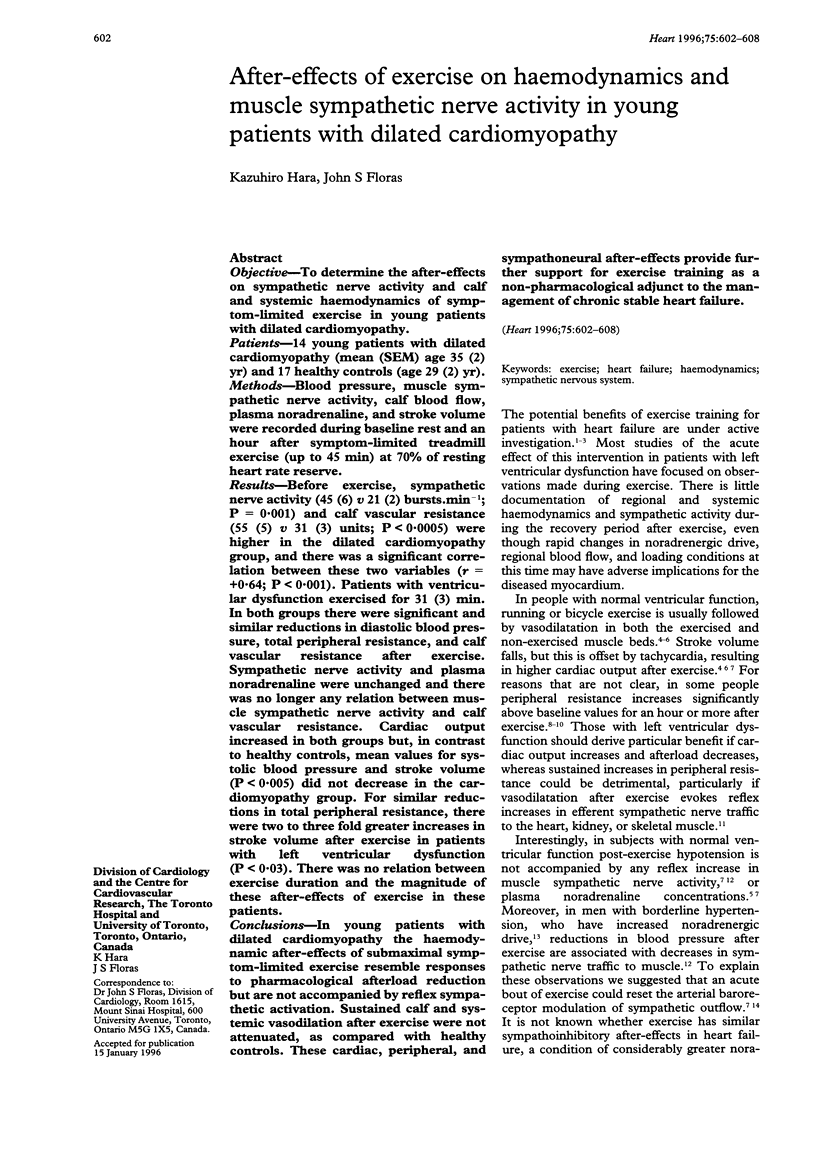

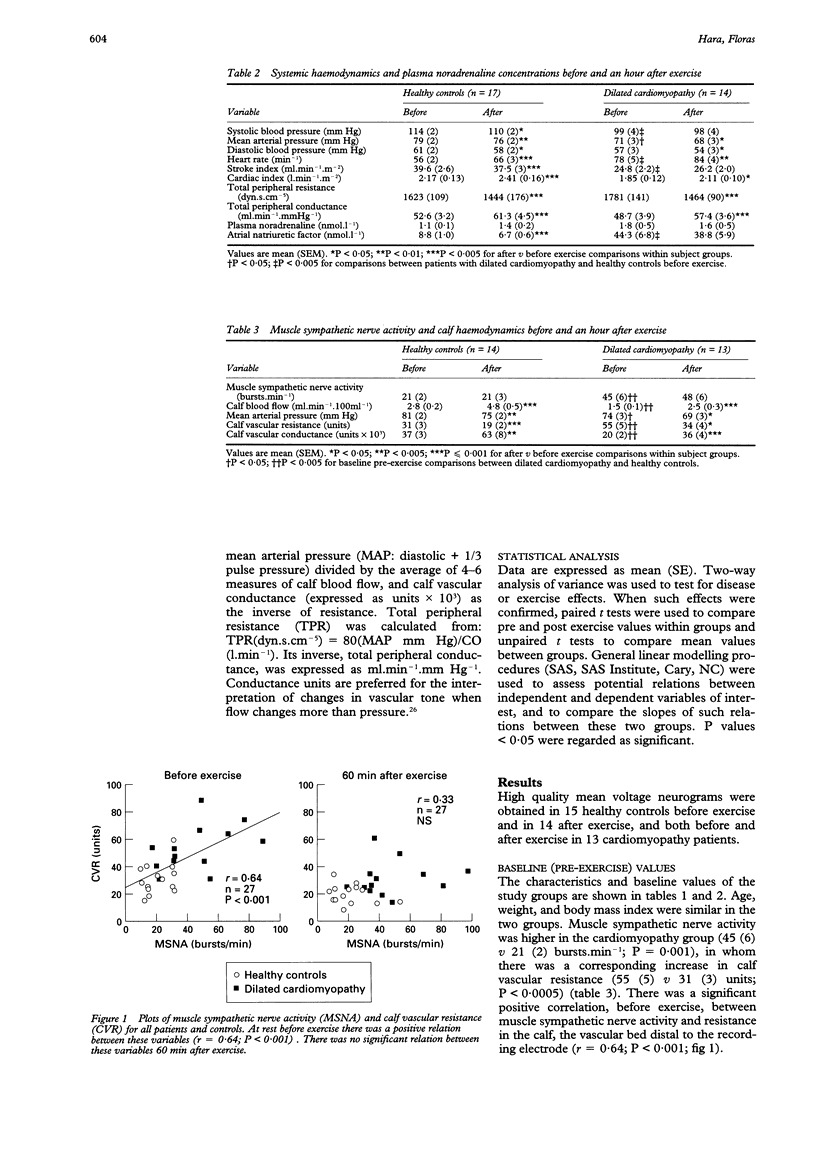
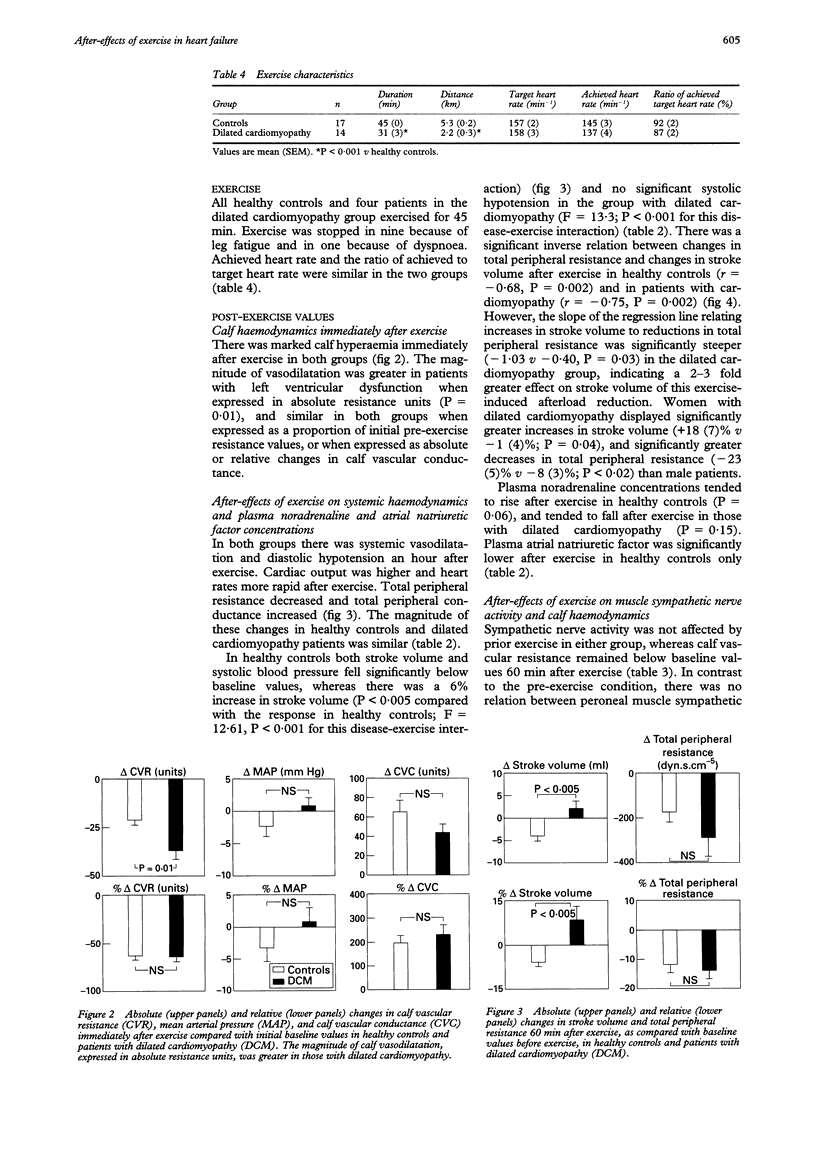

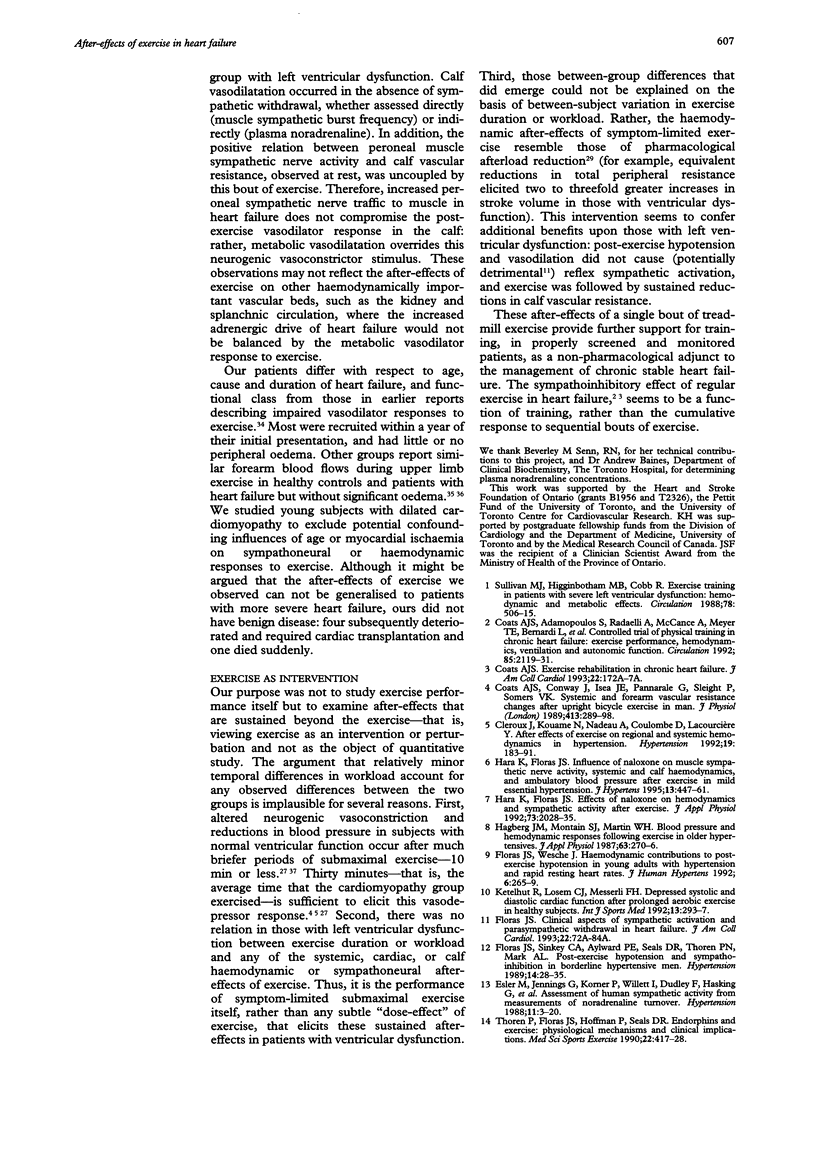
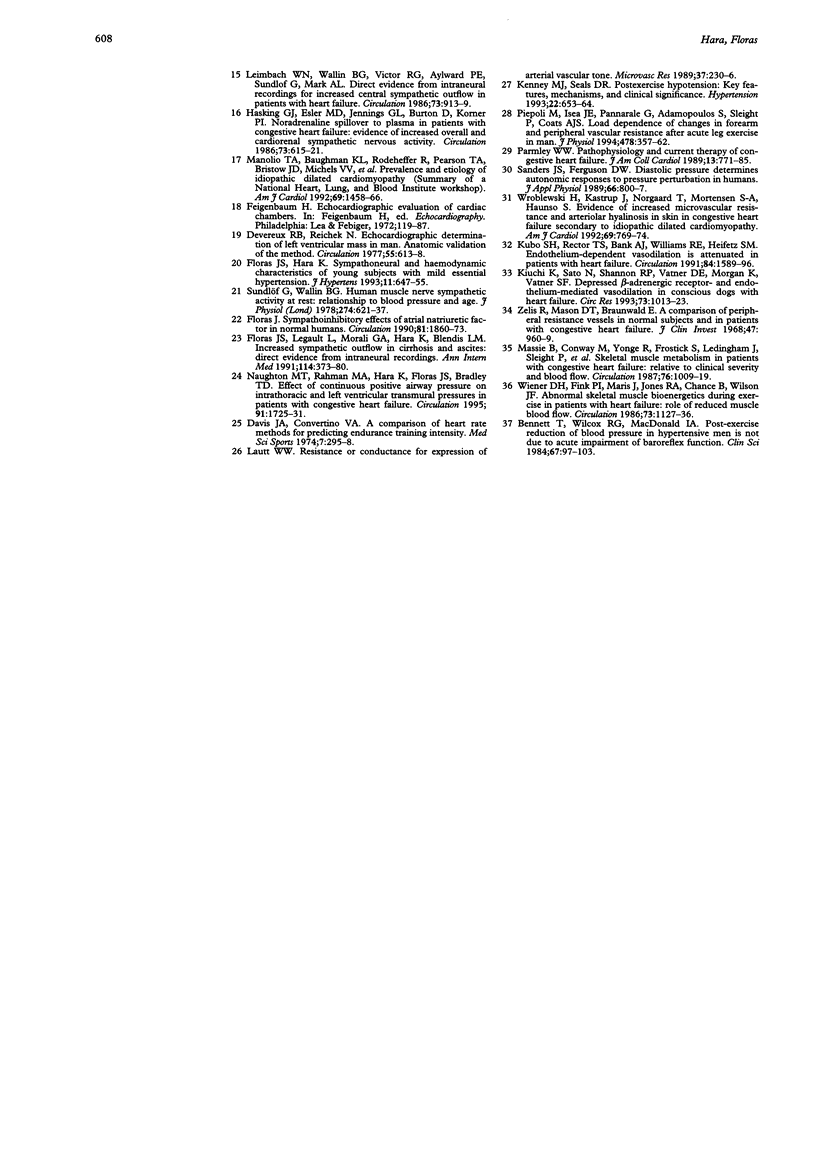
Selected References
These references are in PubMed. This may not be the complete list of references from this article.
- Bennett T., Wilcox R. G., Macdonald I. A. Post-exercise reduction of blood pressure in hypertensive men is not due to acute impairment of baroreflex function. Clin Sci (Lond) 1984 Jul;67(1):97–103. doi: 10.1042/cs0670097. [DOI] [PubMed] [Google Scholar]
- Cléroux J., Kouamé N., Nadeau A., Coulombe D., Lacourcière Y. Aftereffects of exercise on regional and systemic hemodynamics in hypertension. Hypertension. 1992 Feb;19(2):183–191. doi: 10.1161/01.hyp.19.2.183. [DOI] [PubMed] [Google Scholar]
- Coats A. J., Adamopoulos S., Radaelli A., McCance A., Meyer T. E., Bernardi L., Solda P. L., Davey P., Ormerod O., Forfar C. Controlled trial of physical training in chronic heart failure. Exercise performance, hemodynamics, ventilation, and autonomic function. Circulation. 1992 Jun;85(6):2119–2131. doi: 10.1161/01.cir.85.6.2119. [DOI] [PubMed] [Google Scholar]
- Coats A. J., Conway J., Isea J. E., Pannarale G., Sleight P., Somers V. K. Systemic and forearm vascular resistance changes after upright bicycle exercise in man. J Physiol. 1989 Jun;413:289–298. doi: 10.1113/jphysiol.1989.sp017654. [DOI] [PMC free article] [PubMed] [Google Scholar]
- Davis J. A., Convertino V. A. A comparison of heart rate methods for predicting endurance training intensity. Med Sci Sports. 1975 Winter;7(4):295–298. [PubMed] [Google Scholar]
- Devereux R. B., Reichek N. Echocardiographic determination of left ventricular mass in man. Anatomic validation of the method. Circulation. 1977 Apr;55(4):613–618. doi: 10.1161/01.cir.55.4.613. [DOI] [PubMed] [Google Scholar]
- Esler M., Jennings G., Korner P., Willett I., Dudley F., Hasking G., Anderson W., Lambert G. Assessment of human sympathetic nervous system activity from measurements of norepinephrine turnover. Hypertension. 1988 Jan;11(1):3–20. doi: 10.1161/01.hyp.11.1.3. [DOI] [PubMed] [Google Scholar]
- Floras J. S., Hara K. Sympathoneural and haemodynamic characteristics of young subjects with mild essential hypertension. J Hypertens. 1993 Jun;11(6):647–655. doi: 10.1097/00004872-199306000-00009. [DOI] [PubMed] [Google Scholar]
- Floras J. S., Legault L., Morali G. A., Hara K., Blendis L. M. Increased sympathetic outflow in cirrhosis and ascites: direct evidence from intraneural recordings. Ann Intern Med. 1991 Mar 1;114(5):373–380. doi: 10.7326/0003-4819-114-5-373. [DOI] [PubMed] [Google Scholar]
- Floras J. S., Sinkey C. A., Aylward P. E., Seals D. R., Thoren P. N., Mark A. L. Postexercise hypotension and sympathoinhibition in borderline hypertensive men. Hypertension. 1989 Jul;14(1):28–35. doi: 10.1161/01.hyp.14.1.28. [DOI] [PubMed] [Google Scholar]
- Floras J. S. Sympathoinhibitory effects of atrial natriuretic factor in normal humans. Circulation. 1990 Jun;81(6):1860–1873. doi: 10.1161/01.cir.81.6.1860. [DOI] [PubMed] [Google Scholar]
- Floras J. S., Wesche J. Haemodynamic contributions to post-exercise hypotension in young adults with hypertension and rapid resting heart rates. J Hum Hypertens. 1992 Aug;6(4):265–269. [PubMed] [Google Scholar]
- Hagberg J. M., Montain S. J., Martin W. H., 3rd Blood pressure and hemodynamic responses after exercise in older hypertensives. J Appl Physiol (1985) 1987 Jul;63(1):270–276. doi: 10.1152/jappl.1987.63.1.270. [DOI] [PubMed] [Google Scholar]
- Hara K., Floras J. S. Effects of naloxone on hemodynamics and sympathetic activity after exercise. J Appl Physiol (1985) 1992 Nov;73(5):2028–2035. doi: 10.1152/jappl.1992.73.5.2028. [DOI] [PubMed] [Google Scholar]
- Hara K., Floras J. S. Influence of naloxone on muscle sympathetic nerve activity, systemic and calf haemodynamics and ambulatory blood pressure after exercise in mild essential hypertension. J Hypertens. 1995 Apr;13(4):447–461. [PubMed] [Google Scholar]
- Hasking G. J., Esler M. D., Jennings G. L., Burton D., Johns J. A., Korner P. I. Norepinephrine spillover to plasma in patients with congestive heart failure: evidence of increased overall and cardiorenal sympathetic nervous activity. Circulation. 1986 Apr;73(4):615–621. doi: 10.1161/01.cir.73.4.615. [DOI] [PubMed] [Google Scholar]
- Kenney M. J., Seals D. R. Postexercise hypotension. Key features, mechanisms, and clinical significance. Hypertension. 1993 Nov;22(5):653–664. doi: 10.1161/01.hyp.22.5.653. [DOI] [PubMed] [Google Scholar]
- Ketelhut R., Losem C. J., Messerli F. H. Depressed systolic and diastolic cardiac function after prolonged aerobic exercise in healthy subjects. Int J Sports Med. 1992 May;13(4):293–297. doi: 10.1055/s-2007-1021269. [DOI] [PubMed] [Google Scholar]
- Kiuchi K., Sato N., Shannon R. P., Vatner D. E., Morgan K., Vatner S. F. Depressed beta-adrenergic receptor- and endothelium-mediated vasodilation in conscious dogs with heart failure. Circ Res. 1993 Dec;73(6):1013–1023. doi: 10.1161/01.res.73.6.1013. [DOI] [PubMed] [Google Scholar]
- Kubo S. H., Rector T. S., Bank A. J., Williams R. E., Heifetz S. M. Endothelium-dependent vasodilation is attenuated in patients with heart failure. Circulation. 1991 Oct;84(4):1589–1596. doi: 10.1161/01.cir.84.4.1589. [DOI] [PubMed] [Google Scholar]
- Lautt W. W. Resistance or conductance for expression of arterial vascular tone. Microvasc Res. 1989 Mar;37(2):230–236. doi: 10.1016/0026-2862(89)90040-x. [DOI] [PubMed] [Google Scholar]
- Leimbach W. N., Jr, Wallin B. G., Victor R. G., Aylward P. E., Sundlöf G., Mark A. L. Direct evidence from intraneural recordings for increased central sympathetic outflow in patients with heart failure. Circulation. 1986 May;73(5):913–919. doi: 10.1161/01.cir.73.5.913. [DOI] [PubMed] [Google Scholar]
- Manolio T. A., Baughman K. L., Rodeheffer R., Pearson T. A., Bristow J. D., Michels V. V., Abelmann W. H., Harlan W. R. Prevalence and etiology of idiopathic dilated cardiomyopathy (summary of a National Heart, Lung, and Blood Institute workshop. Am J Cardiol. 1992 Jun 1;69(17):1458–1466. doi: 10.1016/0002-9149(92)90901-a. [DOI] [PubMed] [Google Scholar]
- Massie B., Conway M., Yonge R., Frostick S., Ledingham J., Sleight P., Radda G., Rajagopalan B. Skeletal muscle metabolism in patients with congestive heart failure: relation to clinical severity and blood flow. Circulation. 1987 Nov;76(5):1009–1019. doi: 10.1161/01.cir.76.5.1009. [DOI] [PubMed] [Google Scholar]
- Naughton M. T., Rahman M. A., Hara K., Floras J. S., Bradley T. D. Effect of continuous positive airway pressure on intrathoracic and left ventricular transmural pressures in patients with congestive heart failure. Circulation. 1995 Mar 15;91(6):1725–1731. doi: 10.1161/01.cir.91.6.1725. [DOI] [PubMed] [Google Scholar]
- Parmley W. W. Pathophysiology and current therapy of congestive heart failure. J Am Coll Cardiol. 1989 Mar 15;13(4):771–785. doi: 10.1016/0735-1097(89)90215-5. [DOI] [PubMed] [Google Scholar]
- Piepoli M., Isea J. E., Pannarale G., Adamopoulos S., Sleight P., Coats A. J. Load dependence of changes in forearm and peripheral vascular resistance after acute leg exercise in man. J Physiol. 1994 Jul 15;478(Pt 2):357–362. doi: 10.1113/jphysiol.1994.sp020256. [DOI] [PMC free article] [PubMed] [Google Scholar]
- Sanders J. S., Ferguson D. W. Diastolic pressure determines autonomic responses to pressure perturbation in humans. J Appl Physiol (1985) 1989 Feb;66(2):800–807. doi: 10.1152/jappl.1989.66.2.800. [DOI] [PubMed] [Google Scholar]
- Sullivan M. J., Higginbotham M. B., Cobb F. R. Exercise training in patients with severe left ventricular dysfunction. Hemodynamic and metabolic effects. Circulation. 1988 Sep;78(3):506–515. doi: 10.1161/01.cir.78.3.506. [DOI] [PubMed] [Google Scholar]
- Sundlöf G., Wallin B. G. Human muscle nerve sympathetic activity at rest. Relationship to blood pressure and age. J Physiol. 1978 Jan;274:621–637. doi: 10.1113/jphysiol.1978.sp012170. [DOI] [PMC free article] [PubMed] [Google Scholar]
- Thorén P., Floras J. S., Hoffmann P., Seals D. R. Endorphins and exercise: physiological mechanisms and clinical implications. Med Sci Sports Exerc. 1990 Aug;22(4):417–428. [PubMed] [Google Scholar]
- Wiener D. H., Fink L. I., Maris J., Jones R. A., Chance B., Wilson J. R. Abnormal skeletal muscle bioenergetics during exercise in patients with heart failure: role of reduced muscle blood flow. Circulation. 1986 Jun;73(6):1127–1136. doi: 10.1161/01.cir.73.6.1127. [DOI] [PubMed] [Google Scholar]
- Wroblewski H., Kastrup J., Nørgaard T., Mortensen S. A., Haunsø S. Evidence of increased microvascular resistance and arteriolar hyalinosis in skin in congestive heart failure secondary to idiopathic dilated cardiomyopathy. Am J Cardiol. 1992 Mar 15;69(8):769–774. doi: 10.1016/0002-9149(92)90503-q. [DOI] [PubMed] [Google Scholar]
- Zelis R., Mason D. T., Braunwald E. A comparison of the effects of vasodilator stimuli on peripheral resistance vessels in normal subjects and in patients with congestive heart failure. J Clin Invest. 1968 Apr;47(4):960–970. doi: 10.1172/JCI105788. [DOI] [PMC free article] [PubMed] [Google Scholar]


